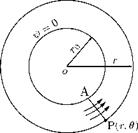Line (point) Vortex
A line vortex is a string of rotating particles. In a line vortex, a chain of fluid particles are spinning about their common axis and carrying around with them a swirl of fluid particles which flow around in circles. A cross-section of such a string of particles and the associated flow show a spinning point, outside of which the flow streamlines are concentric circles, as shown in Figure 5.8.
Vortices can commonly be encountered in nature. The difference between a real (actual) vortex and theoretical vortex is that, the real vortex has a core of fluid which rotates like a solid, although the associated swirl outside is the same as the flow outside the point vortex. The streamlines associated with a line vortex are circular, and therefore, the particle velocity at any point must be only tangential.
Stream function of a vortex can easily be obtained as follows. Consider a vortex of strength Г, at the origin of a polar coordinate system, as shown in Figure 5.9.
Let P(r, в) be a general point and velocity at P is always normal to OP (tangential). The radial velocity at any point P is zero, that is:
![]() 1 df г ~дв
1 df г ~дв
![]()
![]()
 |
since in polar coordinates, the radial velocity qr and tangential velocity qe, in terms of stream function f are: 1
For qr = 0, the stream function ф should be a function of r only. The tangential velocity at any point P [1] is:
_ Г _ дф 2 nr dr
Therefore,
Integrating along a convenient boundary, such as from A to P in Figure 5.9, from radius r0 (radius of streamline, ф = 0) to P(r, в), we get the stream function as:
![]() — ln r _2n
— ln r _2n
that is:
This is the stream function for a vortex, and the circulation Г of a flow is positive when it is counterclockwise.[3]
We know that the streamlines of a line vortex are concentric circles. Therefore, the equipotential lines (which are always orthogonal to the streamlines) must be radial lines emanating from the center of the vortex. Also, for a vortex, the normal component of velocity qn = 0. Therefore, the potential function ф must be a function of в only. Thus:
1 аф _ Г r de 2nr
Therefore:
Г
аф = — ав.
2n
Integrating this, we get:
Г
ф = — в + constant. 2n
By assigning ф = 0 at в = 0, we obtain:
This is the potential function for a vortex.
Also, we know that the stream function for a source [1] is:
where m is the strength of the source.
Comparing the stream functions of a vortex and a source, we see that the streamlines of the source (the radial lines emanating from a point) and the streamlines of the vortex (the concentric circles) are orthogonal.











